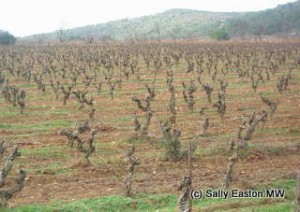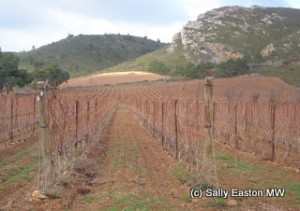Corbières Boutenac
A developing theme in the Languedoc is that of a small band of crus appellations, or stand-out regions, which are capable of producing better wines than the generic Languedoc appellations. The principle is the same as the southern Rhône crus such as Gigondas and Vacqueyras that have forged their own identity, away from generic Côtes du Rhône.

Corbières-Boutenac
In the Languedoc, Corbières-Boutenac is one of the more recent areas to achieve its own cru appellation, following the lead set by Minervois La Livinière in 1998. Prior to the 2005 vintage, the area of Corbières-Boutenac was merely an area of the ‘straightforward’ Corbières appellation, though the area has been working for some decades to achieve cru status.
With just 1,429 hectares, Boutenac produces not even 1% of Corbières production, which is the largest appellation in the whole of the Languedoc.
The larger Corbières is a mountain massif all its own, crushed into the foothills of the Pyrenees, and it was the land of the Cathars. The relics of their strongholds jut defiantly from atop the highest rugged outcrops.
Boutenac is situated as the beating heart of this ‘straight’ Corbieres. The area, with a plum Mediterranean climate, is protected from the waning Atlantic Ocean influence, as it lies on the east and south facing slopes of the Pinede hill, and it is protected from the Mediterranean by the Fontfroide hills in the east. This means it is very dry, as well as being one of the warmest areas in Corbières.
A saving grace is that the deep clay-limestone soils have good water retention capabilities, to provide moisture through the dry summer. The other climatic adaptation is that the appellation’s signature grape variety is drought resistant, and needs a long ripening time late into the season.
Carignan is king in Corbières-Boutenac. As well as being drought-resistant, it produces powerful, deeply coloured wines with plentiful tannin.
Historically carignan was the workhorse variety, grown as a bulk wine, or blended to add colour and some grip. But there’s been a change in the way carignan is worked in Boutenac, taking more care in the vineyard and using a mix of carbonic maceration and traditional fermentations in the winery, enabling interesting wines to be put into bottle, standing on their own account.

More Corbières-Boutenac
And since not much carignan has been planted in the last quarter of a century, plenty of carignan is building the flavour concentration and balance of venerable vine age. Pierre Bories, the winemaker at Château Ollieux Romanis said “you need to wait 50 years for carignan to give little [concentrated] grapes” though he added “using selection massale at Ollieux Romanis we found that vines can give good grapes after 10 years.“ Certainly producers are viewing carignan in a completely different light.
The finished wines of Corbières-Boutenac are always a blend. The small supporting cast comprises grenache, mourvèdre and syrah, though this latter may comprise no more that 30% of the blend, while carignan must be at least 30%, and up to half of any blend. Mourvèdre is equally late ripening, and grenache is also drought-resistant. The wine must be a blend of carignan plus at least one other, which leaves plenty of opportunity for stylistic individuality within the appellation.
The typical Boutenac style is said to be of black fruit, with spice and mocha in an intense palate with big soft tannin. In tastings during my visit I found fresh acidity despite the warmth of the zone, a big volume of fruit, and dry, with supple, sometimes sweet tannins reminiscent of the succulent tannins of the new world. The fresh acid core and full dryness still marked the wines out as old world. The tannins were often elegant as well as prodigious. The sometimes high alcohol was nearly always neatly and inconspicuously integrated. The wines were eminently drinkable. Almost all deeply, darkly coloured.
Crop of the tasting notes, in situ, January 2010
Domaine de la Bouysse, Mazérac 2007, Corbières-Boutenac
80% carignan and 20% grenache. Dense, dark berry fruit nose, hints of graphite, some complexity on the nose, soft palate attack, full body, black, iron and graphite notes with rich, sweet fruit. Decent palate length, with good volume of fruit.
Château Aiguilloux, Cuvee Anne-Georges 2007, Corbières-Boutenac
Mostly carignan, up to 70 years old, with syrah. Red berry fruit, with notes of iron mid palate, fine tannin, fresh core, nicely framed. Rich, sweet fruit with dry, almost refreshing finish.
Château Sainte Lucie d’Aussou, 2007, Corbières-Boutenac
50% carignan, with grenache and syrah. Rich, dark, musky berry nose, succulent palate attack, sweet fruit, dry and fresh core. Big volume of big, sweet fruit, lush tannins, full body. Very clean style with core of spice, and dark berries.
Château Maylandie, Villa Ferrai 2006, Corbières-Boutenac
Bright red cherry fruit, with a fresh acid core and a medium-full body. Attractive, bright, fresh and balanced, with some gentle elegance.
Domaine Grand Lauze, Ledogar 2006, Corbières-Boutenac
50% carignan, 30% mourvèdre, 10% each of grenache and syrah. Sweet graphite and slate nose, black fruit and sweet; silky texture, long palate length, rich and blossoming in the mouth. Fine textured, elegance to the fruit of dark, dark dark berries. Delicious.
Château Grand Moulin, 2006, Corbières-Boutenac
40% carignan, 60% mourvèdre. Smoke, aromatic tar, liquorice, complex nose, followed by big, full, muscled attack, well toned. Sweet fruit, not lush but well proportioned, dark and brooding texture. Nicely balanced with long finish.
Château Fabre Gasparets, Chimere 2006 Corbières-Boutenac
40% carigan 30% each of grenache and syrah. Almost black in colour with hints of graphite on the nose, and aromatic tar on palate attack, with sweet fruit in a savoury framework, all nicely balanced. Big concentration without being butch or crass, with full body, sweet fruit, and still has that freshness at heart. Good.
Château Saint Jean de La Ginestre, Crepuscule 2008, Corbières-Boutenac
40% carignan, 30% each of grenache and mourvèdre. Very young; bright, black, dark brooding. Supple, almost purple fruit, lush and sweet, and with that freshness. Balanced, attractive, with supple tannins. Good.
This article was inspired by a visit to the region sponsored by the CIVL (Conseil Interprofessionnel des Vins du Languedoc).
Comments
One Response to “Corbières Boutenac”




April 30, 2010 at 10:27 am
Dear Mrs Easton,
On behalf of Martine Pages and Christophe Molinier, I would like to thank you very much for having included our wine and your tasting comments on your website.
We surely forgot to tell you in January that our cuvée “Mazerac” is made of 80% of carignan old vines and 20% of red grenache from old vines too. It was Martine’s decision, when they took over from their father with her brother Christophe, not to plant or buy vines of syrah in the Boutenac area, to follow a family tradition.
Frederic Lamboeuf
Domaine de La Bouysse
06 37 13 62 39